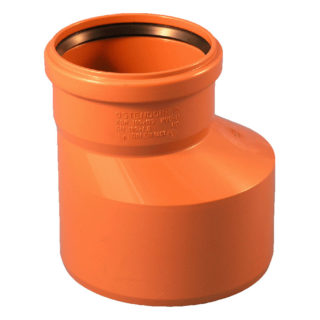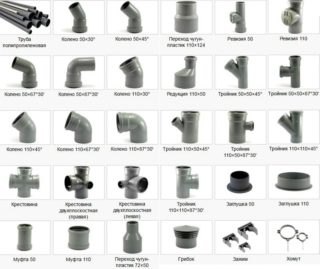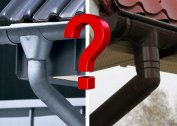Pipes alone are not enough to create an ideal sewer network. It is necessary to select high-quality connecting elements - adapters. They perform different functions and can be made of cast iron, steel, copper, polymeric materials - polyvinyl chloride and polypropylene. The operation of the entire sewage pipeline depends on the correct selection of fittings.
Purpose of sewer adapters
Many elements have been invented, and each has its own purpose. The general purpose of their application is to create highways of complex configuration and save space without losing quality capabilities.
With the help of sanitary fittings:
- carry out the transition to a different pipe length;
- change the direction of the highway;
- sewer discharge and aggressive drains.
Adapters allow you to assemble pipe segments of different sections into a single whole, connect branches made of metal and plastic, and connect any plumbing. They come in handy if you need to bring threaded elements to the non-pressure part of the line, which are equipped with pumps for pumping and wastewater treatment. To save even more space, products can be corrugated so that they can take any shape.
Types and design features
Most varieties of transition elements are used in both external and internal sewers. They, like pipes, vary in shade. Outside they put red products, inside - gray and white.
The most popular transition elements:
- Adapter. Designed to connect connectors with a union nut to fittings with conical outlets of the appropriate diameter - to manifolds or valves.
- Fitting Connects a plastic drain hose to a metal pipe.
- Swivel bend with an angle of 90, 30 and 45 degrees. Need to change direction. There are options with threaded threads for easy connection of the mixer.
- Crosspiece and tee. Shaped elements allow you to connect several pipe segments, sometimes with different sections, into one node. Metal elements may be provided with internal or external threaded threads.
- Coupling. Its use is advisable if the connected pipes have the same diameter and wall thickness.
- Reduction. Needed to connect parts that vary in diameter.
- Contour. A curved part is used to reduce the number of docking assemblies, which reduces the risk of accidents.
- Compensator. Able to give the desired slope to horizontal sections of the highway, smooth out temperature differences, soften water hammer. Without it, parts of the system can be deformed.
- Saddle. The part has two parts that compress the pipe. It is needed to correctly insert the pipe system.
- Two-knee siphon. The part is installed in places where wastewater is being received. Eliminates toxic gases and improves ventilation. At home, bottle products of a similar configuration serve to collect wastewater under sinks and washbasins.
The transition elements include revision hatches. Revision is needed so that the plumber can check the condition of the sewer system, and if necessary, clear the blockages through them.
All shaped transition elements are either concentric or eccentric. The former are suitable for mounting the pipeline vertically, the latter horizontally.
Production material
At home, plastic pipelines are most often mounted. In accordance with the material for the manufacture of the main branches, adapters of polypropylene or PVC are chosen.
Advantages of polymer elements:
- impossibility of corrosion;
- light weight;
- ease of installation;
- a large assortment;
- budget cost;
- no need for specialized tools for installation.
Polypropylene parts create greater tightness of the connection, especially if it is made by welding. The work is carried out with a special soldering iron and special nozzles.
The disadvantages of plastic products include less strength in comparison with metal. They can not tolerate extremely high or low temperatures, unnecessarily aggressive chemical effects. But in everyday life there are no such extremes, and polymer elements are quite suitable for home sewage.
Cast iron products - strong, durable, resistant to water shocks and temperature extremes. They are also inexpensive. The only negative is that the adapters are quite heavy.
Copper and steel (usually also with the addition of copper) parts are used where a threaded connection is indispensable. Cutting can be applied both inside and outside. These are durable but lightweight products. To improve their anti-corrosion properties, they are coated with zinc or nickel plating. The disadvantage is the price - such parts are more expensive than analogues from other materials and are not always suitable for pipelines made of polymers.
Sizes and recommendations for selection
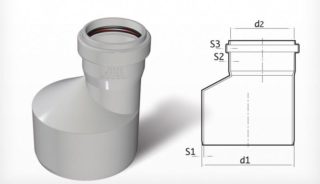 In terms of dimensions, shaped products are diverse. But the dimensions of the cross sections of sewer pipes and adapters made of metal, PVC or other polymers must match. When assembling the sewage pipe sections are used:
In terms of dimensions, shaped products are diverse. But the dimensions of the cross sections of sewer pipes and adapters made of metal, PVC or other polymers must match. When assembling the sewage pipe sections are used:
- for internal highways - from 50 mm;
- for the outer part of the pipeline - from 110 mm;
- for sewer nets for several buildings - from 315 mm;
- for a centralized citywide system - from 630 mm.
In order to choose the right adapter for the sewer pipe, you need to consider where this segment will be located. Wastewater from the bathtub, shower, washbasin is discharged through pipes with a cross section of 50 mm or more. Sewage from the toilet should go down the highway with a diameter of at least 110 mm. The desired diameter of the risers is from 150 mm.
Going for building materials, create a scale drawing of the sewage system. This will help to clarify the length of all pipe segments, the number of fittings of different types. In order not to make a mistake with the dimensions, decide whether the shaped element will be worn on the pipe or inserted inside it. If possible, use contours to reduce the number of tie-ins.
Accurately calculate the bending angle. The smaller it is, the better the sewage system functions. All internal turns accumulate dirt, causing odor and causing an increase in pressure in the network.
The price of sewer adapters is low: reduction can cost from 20 to 200 rubles, tap - from 100 to 350 rubles, tee or crosspiece - from 200 to 500 rubles, coupling - from 100 to 250 rubles. The average cost of audits is 500 rubles.
Mounting Features
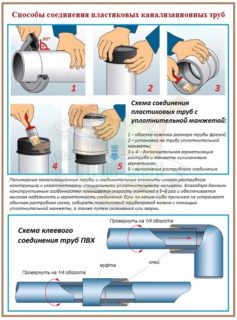 The reinforcement is divided by the method of connection. It is threaded, welded, glued and rubber. In the latter case, a rubber cuff is used as a connector and a sealant.
The reinforcement is divided by the method of connection. It is threaded, welded, glued and rubber. In the latter case, a rubber cuff is used as a connector and a sealant.
There are two ways to install this part on a cast iron pipe. In the first case, the cuff is placed inside. Pre-docking area is cleaned of dirt and rust, treated with sandpaper and coated with plumbing grease. Then install the cuff and insert another piece of pipe. This method is possible only if there is a bell on the pipe section. If not, the cuff is mounted externally:
- The outer surfaces of the pipe sections are cleaned of dirt and polished.
- Small chamfers are made at the ends from the outside for the convenience of putting on the cuff.
- Sealing silicone is applied to the ends of the pipes and they are connected using a rubber adapter.
Usually one of these docking methods is chosen if a connection of cast-iron and plastic sewer branches is required.
In polymer systems, the connection is due to the internal o-ring. Structurally, this is already provided by the manufacturer. The part is mounted on the smooth end of the pipe segment, after which the adapter is put on top. However, this method is only suitable for internal gravity drainage. External elements in pressure networks are additionally sealed with a special adhesive composition:
- The end part of the pipe is treated with sandpaper.
- Apply an adhesive mixture at a distance of about two centimeters from the edge.
- They wait two minutes for the glue to thicken.
- Insert the pipe section into the corresponding hole in the adapter.
Sewerage can be used when the mixture hardens (it depends on the composition and manufacturer). The time is indicated in the instructions for use.
To assemble polypropylene pipes and fittings, the welded method is often used with the help of special soldering devices. Due to the fact that the products are made of a similar material, when connecting the molten sections, a bond occurs at the molecular level.
Metal parts are threaded or used for caulking a linen seal. The gaps between the flax wound on the pipe and the adapter are filled with cement mortar. Hammered joints are reliable, but difficult to dismantle.
Sometimes, only a moisture-proof sealant is used to connect the pipe section and the shaped part. This method is simple and affordable: it is enough to apply the composition to the surface, connect them and wait for the polymerization (from 4 hours to a day). But this is advisable if the pipe cross-section is small and the gaps are less than 2 mm. Otherwise, it is better to use a combination of sealant and o-ring, rubber cuff or linen fiber.
The choice of high-quality and reliable parts for connecting pipe sections is the guarantee that the sewage system will work reliably and will not require repair for a long time.
